Are you having trouble figuring out the best distance for your fruit trees? Getting the spacing right is key for your trees’ health and how much they produce. Many gardeners forget this important step. We’re here to help you understand why spacing matters and how to do it right.
Understanding the Importance of Proper Fruit Tree Spacing
Proper fruit tree spacing is key for a healthy orchard. Adequate spacing lets each tree get enough sunlight, water, and nutrients. This way, trees grow well and produce more fruit. Trees that are too close fight over these things, leading to less growth, fewer fruits, and more pests.
Why Spacing Matters for Optimal Growth and Yield
The size a fruit tree gets is important for how far apart it should be planted. Standard fruit trees can grow 18 to 25 feet tall. Semi-dwarf trees are about 12 to 15 feet tall, and dwarf trees are 10 to 15 feet wide and tall. With enough space, trees can spread out and grow strong roots. This is key for good growth and lots of fruit.
Factors Affecting Fruit Tree Spacing Requirements
- Tree’s mature size and growth habit
- Local climate and soil conditions
- Pollination requirements (fruit trees should be planted within 100 feet of each other)
- Airflow and disease prevention
- Access to water and soil nutrients
- Ease of maintenance and harvesting
Knowing how to space fruit trees right helps you grow a great urban orchard. It makes sure your trees work well together and you have fewer problems.
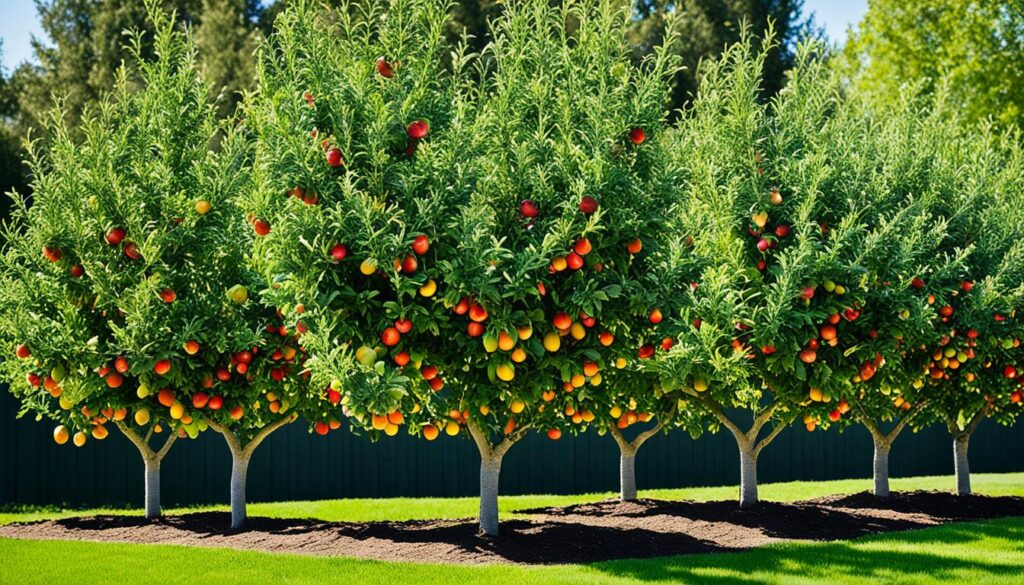
Determining the Right Spacing for Your Fruit Trees
When planning your fruit tree orchard, think about the trees’ mature size. Choose the right spacing based on this size. The size of your trees – dwarf, semi-dwarf, or standard – affects how far apart they should be planted.
Choosing Between Dwarf, Semi-Dwarf, and Standard Sizes
Dwarf fruit trees grow 8-10 feet tall and wide. They can be planted 10-12 feet apart. Semi-dwarf trees, 12-15 feet tall, need 15-20 feet between them. Standard trees, up to 25 feet tall and wide, should be 20-35 feet apart.
Pick the tree size that fits your space and fruit goals. Knowing the mature size helps you choose the best optimal fruit tree spacing. This way, you can make a smart choice for your garden.
| Fruit Tree Size | Mature Height and Width | Recommended Spacing |
|---|---|---|
| Dwarf | 8-10 feet | 10-12 feet |
| Semi-Dwarf | 12-15 feet | 15-20 feet |
| Standard | Up to 25 feet | 20-35 feet |
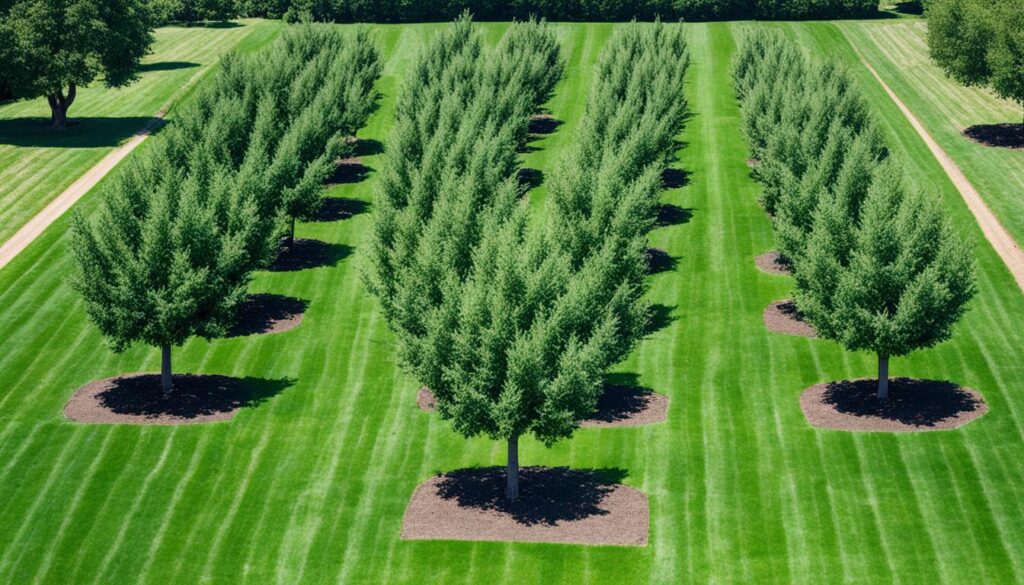
Think about your fruit trees’ mature size and pick the right dwarf fruit tree spacing, semi-dwarf fruit tree spacing, or standard fruit tree spacing. This ensures your orchard stays healthy and productive over time.
Ideal Fruit Tree Distance for Different Varieties
Planting fruit trees needs the right spacing, which changes with each type. Knowing how big each tree will get is key to giving them enough room. Let’s look at the best spacing for some common fruit trees:
- Apple and Pear Trees: These trees need 20-35 feet apart for growth.
- Citrus Trees: Citrus trees do well with 8-12 feet between them, perfect for small yards.
- Stone Fruit Trees: Peaches and plums need 15-25 feet apart to grow well.
Choosing the right spacing for fruit trees helps make a balanced garden. It meets the needs of your plants.
| Fruit Tree Variety | Recommended Spacing | Approximate Height |
|---|---|---|
| Dwarf Apple | 8-10 feet between trees, 16 feet between rows | 8-12 feet |
| Semi-Dwarf Apple | 10-12 feet between trees, 18 feet between rows | 10-14 feet |
| Half-Standard Apple | 14 feet between trees, 20 feet between rows | 12-16 feet |
| Standard Apple | 30 feet between trees, 40 feet between rows | 16-30 feet |
| Dwarf Pear | 8 feet between trees, 15 feet between rows | 11-15 feet |
| Semi-Standard Pear | 12 feet between trees, 18 feet between rows | 16-22 feet |
| Standard Pear | 18 feet between trees, 22 feet between rows | 18-25 feet |
Think about the spacing for apple trees, spacing for pear trees, spacing for citrus trees, and spacing for stone fruit trees. This way, you can have a fruit tree garden that’s both beautiful and productive.
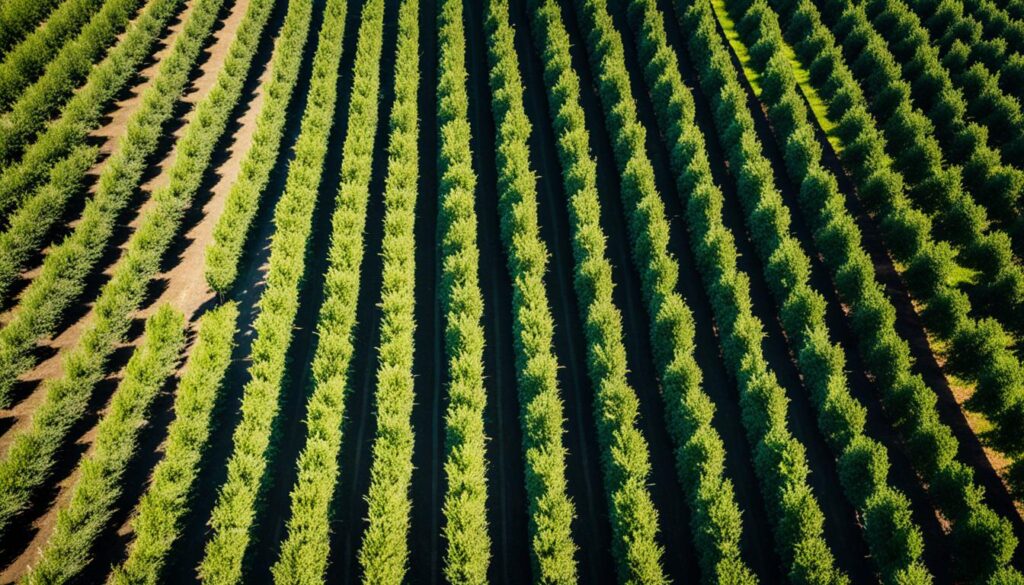
Fruit Orchard Layout: Row Spacing and Walkway Considerations
Designing your fruit orchard well is key for using space well and making it easy to take care of and pick fruit. Leave 10-15 feet between trees and 15-20 feet between rows for walkways. This optimal fruit tree spacing design uses space well and lets you move easily between trees. Also, smart walkway spacing for fruit trees makes your orchard look good and easy to get around in.
Maximizing Space with Proper Row and Walkway Spacing
Plan your row spacing for fruit trees to make a pretty and useful layout. The right spacing lets trees grow well and makes it easy to do things like pruning and picking. It also means you can move around your fruit orchard layout easily, making work simpler.
| Fruit Tree Variety | Recommended Spacing |
|---|---|
| Dwarf Apple Trees | 10 feet apart |
| Semi-Dwarf Apple Trees | 15 feet apart |
| Standard Apple Trees | 20-25 feet apart |
| Apricot Trees (Full-Size) | 20-25 feet apart |
| Dwarf Apricot Varieties | 8-10 feet apart |
| Avocado Trees (Full-Size) | 30 feet apart |
| Dwarf Avocado Varieties | 10 feet apart |
Follow these row spacing for fruit trees and walkway spacing for fruit trees tips. You’ll get a pretty and useful fruit orchard layout. This will make the most of your space and improve how well and pretty your fruit trees grow.
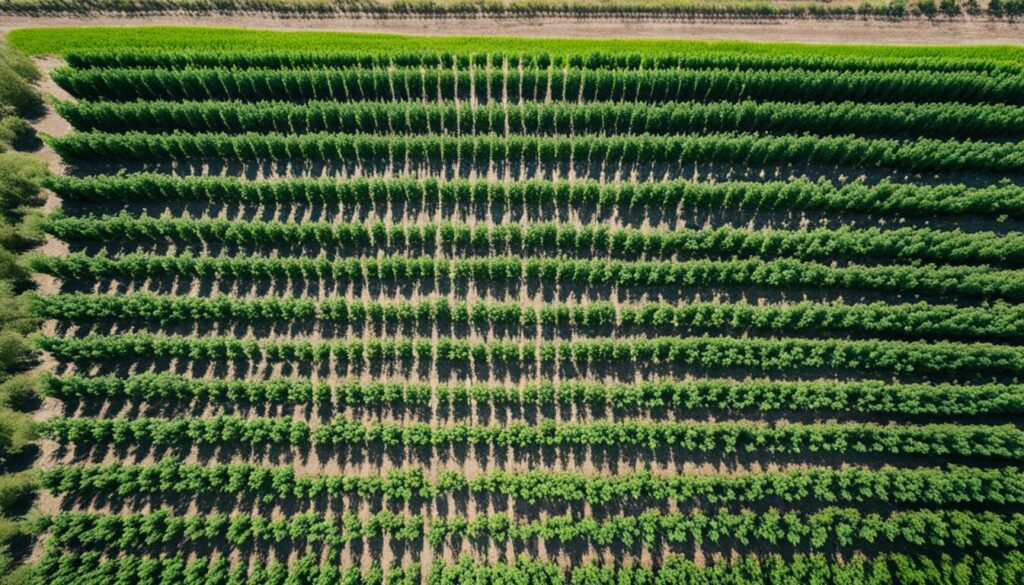
Proper Fruit Tree Spacing for High-Density Planting
If you have little space, you can use high-density fruit tree planting. This lets you grow more trees in a small area. But, you’ll need to prune and train the trees more often.
Cordon Espalier Fruit Tree Spacing
Cordon espalier fruit trees grow up in one stem. You can put them 18-24 inches apart. This way, you can have many cordon espalier trees in a small area. They make a beautiful and fruitful fruit tree hedge.
Horizontal Espalier Fruit Tree Spacing
Horizontal espalier trees grow along a trellis or fence. Keep them 4-5 feet apart. This lets them spread out but still be close together for a high-density fruit tree planting.
Fruit Tree Hedge Spacing
Planting fruit tree hedges, like citrus trees, close together is another option. You can put them 3 feet apart. This makes a thick, fruitful, and nice-looking screen or border.
Using any high-density method, pruning and training are key. They help the trees stay small and get enough sunlight and air. With the right care, you can have lots of fresh fruit in a small area.
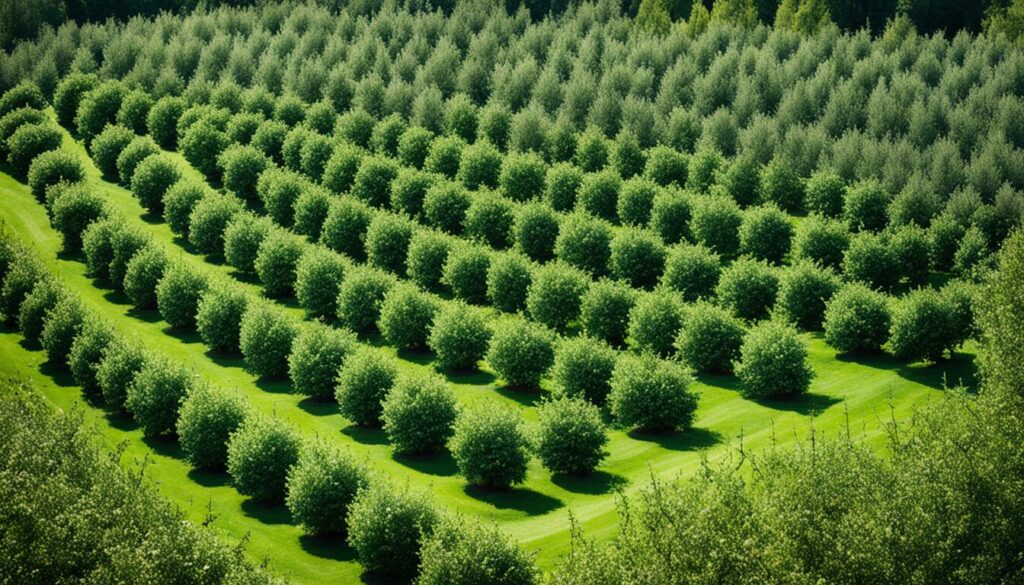
Single Hole Planting: A Space-Saving Technique
For those with little backyard space, single hole fruit tree planting is a smart choice. This method lets you plant 2 to 4 different fruit trees in one hole. It makes a small area work harder, giving you a variety of fruits in less space.
Choosing trees from the same family, like citrus or avocado, is key. It helps them get along and use resources well. Regular pruning keeps the trees the right size and stops one from taking over.
Up to 5 fruit trees can fit in one hole, but usually, 3 are planted. This method works well with apple trees for 4 years. It’s great for healthy growth and looks like one tree from many plants.
If you have limited backyard space and want to try multi-variety fruit tree planting, think about space-saving single hole planting. With the right trees and some pruning, you can get more fruit without taking up much room.
Incorporating Fruit Trees into Your Landscape Design
When planning your fruit tree landscape design, think about how the trees will fit into your outdoor space. Placing fruit trees right can make your landscape look better and be more useful. For example, espalier-trained fruit trees can make living fences or screens, adding beauty and lots of fruit.
Think about where and how far apart to put your fruit trees. This balance of aesthetics and functionality makes your landscape both beautiful and useful.
Aesthetics and Functionality: Balancing Beauty and Productivity
Urban fruit trees fit well into small spaces, letting you pick fresh fruit easily. Using fruit trees in your edible landscape makes the most of your space. They come in sizes like dwarf and super-dwarf, fitting into different spots.
When picking fruit tree varieties, think about chill hours and if they need another tree to pollinate. Where you put the trees matters for things like dropping fruit, upkeep, and getting to them for pruning and picking. Adding fruit trees to your design means you get fresh, homegrown food all year.
For fruit tree hedges, use dwarf or semi-dwarf trees that don’t need much pruning. You can space them from 2 feet to a foot apart, depending on the size. Espalier-trained trees need about 4 to 5 feet between them, while those trained up can be closer. Make sure trees that need to pollinate each other are within 100 feet of each other.
Plan where and how far apart to put yourfruit trees. This way, you get a beautiful and productivefruit tree landscape design that looks great and works well.
Pruning Techniques for Maintaining Optimal Spacing
Proper pruning is key for keeping your fruit trees at the right distance apart. Regular pruning helps control tree size and shape. This way, trees don’t grow too big and fight over space and resources.
Summer pruning is a great way to keep trees balanced and spaced right. It means cutting branches to keep the canopy even. This is super helpful for dwarf and semi-dwarf trees, which grow fast and can get too close together.
Another way to keep trees spaced out is by removing certain branches. This is called selective branch removal. You pick and cut branches that are too close or block sunlight for others. This lets each fruit-bearing branch get enough light and air.
If you have little space, training methods like espalier are great. Espalier means pruning and arranging branches to grow flat. This way, you can make the most of a small area. Using a cordon or horizontal espalier system, keeping trees pruned right is key for their shape and size.
Using these pruning strategies in your tree care routine helps your orchard stay healthy and full of fruit. Even as trees grow and fill their space, they’ll keep producing well.
Common Mistakes to Avoid When Spacing Fruit Trees
Proper spacing is key for your fruit trees’ health and productivity. But, many growers make mistakes that can hurt their trees. Knowing these mistakes helps you space your trees right and boost your orchard’s yields.
One big mistake is overcrowding the trees. If trees are too close, they don’t get enough air. This leads to more pests, diseases, and less fruit. Always follow the right spacing for each tree type to let them grow well.
Another mistake is not thinking about the trees’ full size. Many growers don’t plan for how big their trees will get. This leads to a messy orchard. It’s important to know how big your trees will be to plan your space well.
Not leaving enough room for walkways and access is another mistake. If paths are too narrow, you can’t do important tasks like pruning or spraying. This hurts your orchard’s health and productivity.
By watching out for these mistakes, you can make your orchard thrive. This way, you’ll have plenty of fruit for years.
Key Takeaways:
- Avoid overcrowding fruit trees to maintain proper air circulation and reduce pest/disease issues.
- Accurately estimate the mature size of your fruit trees to allow for adequate spacing.
- Leave sufficient space between rows for walkways and easy access to your trees.
Expert Tips for Successful Fruit Tree Spacing and Growth
Getting advice from experts can really help with growing fruit trees. They suggest doing your homework on the trees you want to grow. Think about your local weather, soil, and how much space you have.
Experts say to use high-density planting to make the most of your land. This way, your trees can grow well and produce a lot. Also, pruning trees helps keep them the right size and shape.
Make sure the soil is ready for your trees. It should drain well, have lots of nutrients, and be the right pH for your trees.
By listening to experts and using their tips, you can make your fruit trees thrive. With the right knowledge and care, you’ll get a lot of tasty fruit for years.



